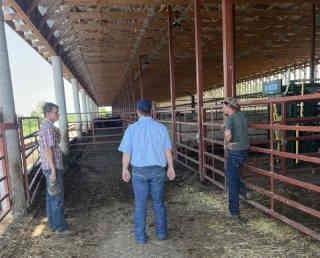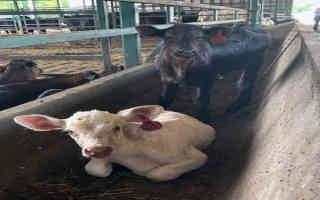By Emily Steele And Travis Meteer
Rising property prices, bad weather, and shrinking pasture acreage challenge Illinois ranchers and limit herd sizes. But what happens when cow and calf producers move cattle into open-air buildings for long periods?

That is what University of Illinois staff and Extension researchers asked early adopters of alternative cow housing systems. Under-roof options, semi-confinement, or extended drylot housing of beef cows are not new strategies, but Travis Meteer, Illinois Extension commercial agriculture educator, says he was getting more questions about how it affected management and herd health.
“Many producers adjust cow housing during drought and limited forage availability as well as for winter feeding and during forage dormancy,” says Meteer. “The key differences from traditional management that we’re examining are how long cows are housed in the semi-confined areas and how the management needs change during extended periods in a building.”
Cows that are housed on pasture are subject to variable weather conditions and forage quality differences, while cows that are housed in alternative systems are generally provided with a consistent, balanced ration that supports their maintenance and sometimes over maintenance.
In the summer of 2022, Meteer and undergraduate intern Sadie Drayer surveyed 20 producers with herds ranging from 50 to more than 400 cows about housing design, technology, herd health, manure management, cover crop use, and feed storage.
Their results show that most farms are newer to using alternative housing. How long ranchers kept cattle in a building varied. Only 25% kept cows under a roof longer than six months. Some producers rotated groups of cows in and out of the building, while others housed other animals on the farm such as feeder calves or fed cattle. Many of these operators housed cows in pasture and on crop residue for the part of the year when they were not in the building. Most of the respondents, 80%, used cover crops for grazing, wet-baling, or chopping and bagging for forage. The ability to harvest forage from cover crops made them a commonly used strategy by the respondents.
Other key findings:

- Cows in alternative systems were fed a consistent, balanced ration. Most respondents fed cattle a total mixed ration. Half of the producers surveyed said cows in a confinement setting were over-conditioned and none answered that they were under-conditioned.
- More than 80% of respondents had pastures with endophyte-infested fescue; which can cause health problems when not managed correctly.
- Fly pressure was lower in barns than in drylots or pastures. This is likely due to air movement and manure management.
- Hoop building users were more likely to allow cows access to a drylot and to use a clay and limed-based floor. They ranked foot rot and pink eye as top potential cow issues and were more concerned about scours than respiratory issues for calves.
- Monoslope building users were most likely to have a concrete floor. They ranked pinkeye as their top potential cow issue and scour as the top calf health concern. None identified calf respiratory issues as a concern.
- Gable-framed building users were more likely to use a clay and limed-based floor. They ranked foot rot as their first potential cow issue and ranked scours and respiratory issues equally as primary calf health concerns.
Meteer says it was evident that innovative farmers have been able to learn and successfully manage cow-calf production in an untraditional way.
“No matter if cows are in a pasture or a building, there isn’t one way to do it, but more producers are looking at alternatives to the traditional production model,” Meteer says.
Meteer says the results show that intensifying beef cow production does not look the same on every farm and the building type impact animal health and management needs and Drayer has submitted an abstract and will present the survey results at the Midwest Animal Science meetings.
“We are so grateful to the participating cattle producers who made this data collection possible,” Meteer says. “The insights they provided will help us focus future University of Illinois research, improve cattle management, and strengthen the future of the cattle industry in the Midwest.”
The research collaborators include University of Illinois staff Josh McCann, animal sciences assistant professor; Dan Shike, animal sciences associate professor; Sadie Drayer, an undergraduate student supported through the Illinois Beef Experiential Learning and Industry Exposure Fellowship; and Nic Anderson, consultant with The Livestock Desk.
Source : illinois.edu